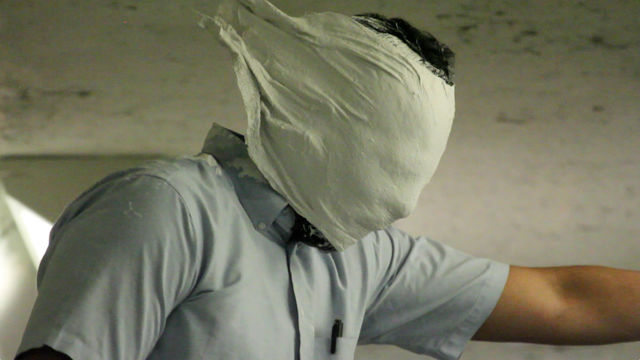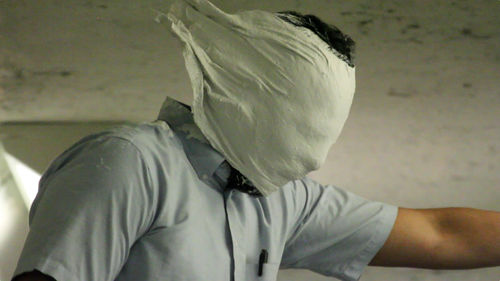
Rafa Esparza: mas gestos y mas caras
- to This is a past program
mas gestos y mas caras is a durational work that narrates the conditions of invisibility and presence through sound and the processes of masking and molding. Dependent on the use of plaster bandages to obstruct Rafa Esparza’s breathing throughout the day, the work will amass an accumulation of white hollow plaster shells embedded with the artist’s "faces," the contortions enabling him to breath during each molding period. Together on the adobe ground, Robert Crouch and Yann Novak will share the duration of the day with Esparza, working with his body, pulling and recording sound from it (his heart beating, his breathing) and then synthesizing the sound, mixing it and at times signaling it back to Esparza, as a chance for intimate exchange, within an expanding public auditorium of recorded and fleeting gestures.
The performance will also introduce objects into the space excavated along with the other unearthed items currently on display in his adobe installation tierra.
Biographies
Rafa Esparza was born in 1981 in Los Angeles. Esparza studied at East Los Angeles College before transferring to the University of California, Los Angeles, where he received his BFA. He currently works in installation, sculpture, drawing, painting, performance, and other mediums and has presented his work at a variety of sites, including traditional fine art contexts and community-based platforms as well as outdoor public locations that he has independently sought out and organized. His work has been shown at Los Angeles Contemporary Exhibitions (2015); Bowtie Project, Los Angeles, with Clockshop (2015); Armory Center for the Arts, Pasadena, CA (2015); and Vincent Price Art Museum, East Los Angeles (2014). He has performed outside the Twin Towers Correctional Facility, Los Angeles (2015); in Elysian Park, Los Angeles (2014); and underneath the viaduct on Fourth and Lorena Streets, in the Boyle Heights neighborhood of Los Angeles (2014). His work was included in the MexiCali Biennial (2013) at the Vincent Price Art Museum and in Native Strategies 3 at Human Resources, Los Angeles (2013). He participated in the symposium “LA/LA Practice and Place” at the Getty Center, Los Angeles (2015). Esparza was awarded a Rema Hort Mann Foundation Emerging Artist Grant (2015), a California Community Foundation Fellowship for Visual Artists (2014), and an Art Matters Grant (2014).
Yann Novak and Robert Crouch are sound and visual artists living and working in Los Angeles. Their practice incorporates field recordings, photography, and video as tools to investigate the relationship between site and subject. Through the digital manipulation of sound and image files, Novak transforms documents of personal experiences into abstracted impressions of the original subject. Crouch uses a combination of digital processing and modular synthesis to further abstract their subject matter.
Their current work explores the relationship between contemporary art-making practices and the historical tradition of romantic landscape painting. Their installations and performances have been presented at the AxS Festival, Pasadena; California Museum of Photography, Riverside; Garboushian Gallery, Beverly Hills; Highways Performance Space, Santa Monica; Los Angeles County Museum of Art; Pøst, Los Angeles; Tanya Bonakdar Gallery, New York; and other venues.
ATTENDING THIS PROGRAM?
ALL HAMMER PROGRAMS ARE FREE
Location: Lindbrook Terrace
Ticketing: This drop-in program is not ticketed.
Parking: Under the museum, $6 for first 3 hours, with validation. $6 flat rate after 6 p.m. Cash only. Validation available at the Welcome Desk in the Wilshire Lobby.
All Hammer public programs are free and made possible by a major gift from an anonymous donor.
Generous support is also provided by Susan Bay Nimoy and Leonard Nimoy, Good Works Foundation and Laura Donnelley, an anonymous donor, The Samuel Goldwyn Foundation, and all Hammer members.
The Hammer’s digital presentation of its public programs is made possible by the Billy and Audrey L. Wilder Foundation.





